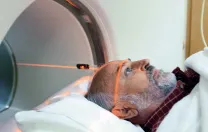abl: A normal mammalian gene that produces a tyrosine kinase enzyme that promotes growth.
adenosine triphosphate (ATP): ATP, present in all cells, is formed when energy is released from food during cell metabolism. Cells contain enzymes such as tyrosine kinases that split ATP into ADP, phosphate, and energy, which is then available for cellular functions such as mitosis (cell division).
amino acid: Any of a class of nitrogenous organic compounds that are the building blocks of proteins and the end products of protein digestion.
bcr-abl: Oncogene and oncoprotein responsible for Philadelphia chromosome-positive chronic myelogenous (myelocytic) leukemia.
breakpoint cluster region (bcr): DNA on chromosome 22 that is the site of breakpoints that accept a fragment of chromosome 9 containing the abl gene. This translocation creates bcr-abl. The modified chromosome 22 is known as the Philadelphia chromosome and is diagnostic of chronic myelogenous leukemia.
c-abl: The normal abl gene, a proto-oncogene.
chromosomal translocation: The alteration of a chromosome by transfer of a portion of it either to another chromosome or to another portion of the same chromosome.
chromosome: A linear strand made of DNA and protein that carries genetic information. Genes are sequences of DNA that are largely contained within chromosomes. Normally present in the somatic (non-germ cells) of humans are 46 chromosomes, including two sex-determining chromosomes (either X and Y in males, or X and X in females).
chronic myelogenous leukemia (CML): A hematological malignancy that includes a specific cytogenetic anomalythe Philadelphia chromosomein the bone marrow and blood of more than 90 percent of patients.
computerized tomography (CT): A radiographic technique that selects a level in the body and blurs out structures above and below that plane, leaving a clear image of the selected anatomy.
deoxyribonucleic acid (DNA): Molecule that carries genetic information for all organisms except the RNA viruses. DNA consists of adenine, guanine, cytosine, thymine, deoxyribose, and phosphate.
enzyme: A protein capable of accelerating the chemical reaction of a substance (the substrate) without being destroyed or altered. Enzymes are reaction specific in that they act only on certain substrates.
gene: A gene consists of a sequence of base pairs in the DNA molecule which encodes the synthesis of one particular messenger RNA and protein molecule. Genes are the basic units of heredity.
gene expression: The process by which genetic information is converted into messenger RNA molecules and then into proteins.
genome: The complete set of genes on chromosomes, and thus the entire genetic information present in a cell.
imatinib (trade names: Gleevec, Glivec): An anticancer drug that inserts itself into the ATP binding pockets of the tyrosine kinase domains of bcr-abl and mutant kit, both oncoproteins. The drug binding prevents ATP access to the enzyme, and therefore blocks tyrosine kinase activity.
kinase: An enzyme protein that catalyzes the transfer of high energy phosphate from ATP to an acceptor or substrate such as a tyrosine molecule within the protein. If tyrosine is the substrate (acceptor) the enzyme is called a tyrosine kinase. If the tyrosine kinase is activated by another protein it is called a receptor tyrosine kinase. Kinase activity is central to the signaling processes that regulate cell growth.
kit: A receptor tyrosine kinase that regulates cell growth and differentiation through the cell signaling network. Mutations of kit are responsible for most cases of GIST.
mutation: A spontaneous or induced change in the DNA sequence of a gene in an individual organism. Most mutations are harmless but others lead to serious disease or disability.
oncogene: A gene that has the ability to induce tumor formation and malignancy. Proteins produced by these genes have tumor-promoting activity.
oncoprotein: A protein that is coded by an oncogene that may induce new and abnormal tissue formation such as a tumor.
Philadelphia chromosome: An abnormally short chromosome 22 in which there is a reciprocal translocation of the distal portion of its long arm to the long arm of chromosome 9 in exchange for the abl gene. It is found in leukocyte cultures of many patients with chronic myelogenous leukemia.
polymer: A natural or synthetic substance formed by a combination of two or more molecules of the same substance.
positron emission tomography (PET scan): A sectional view of the body using glucose labeled with positron-emitting radionuclides. Since cancer cells use glucose more avidly than most normal cells, PET is used to identify and localize tumors and determine their response to treatment.
protein: One of a large class of complex nitrogenous compounds that are synthesized by all living organisms and yield amino acids when hydrolyzed. Proteins are the products of genes, carry out critical metabolic reactions, induce movement, and regulate thought. They make us what we are.
proto-oncogene: A gene that regulates the growth of cells or the signals that cells send to each other. Mutations in proto-oncogenes convert the proto-oncogene to an oncogene that may cause excessive growth of cells or tissues in several diseases, particularly cancers.
RNA: Ribonucleic acid; a nucleic acid found in all living cells. RNA is involved in all stages of protein synthesis as well as in many regulatory and catalytic roles. It consists of adenine, guanaine, cytosine, uracil, ribose, and phosphoric acid.
smart drugs: Anticancer drugs that can target the mutant molecules that induce cancer and do no harm to their healthy counterparts.
src: The first transforming oncogene discovered. It is a mutant tyrosine kinase responsible for the Rous sarcoma in chickens.
tyrosine: An amino acid present in many proteins. It serves as an acceptor for high-energy phosphorus from ATP under the influence of tyrosine kinase.
tyrosine kinase: Any of a group of 90 enzymes that influence signaling between or within cells, particularly those signals that relate to cell growth and death, cellular adhesion and movement, and cellular differentiation. Activating mutations in tyrosine kinases are found in some human diseases, including chronic myelogenous leukemia and GIST.
tyrosine kinase inhibitor: A drug that interferes with tyrosine kinase function and therefore with cell communication and growth and may prevent tumor growth. Tyrosine kinase inhibitors are used to treat cancers that are driven by mutant or overexpressed tyrosine kinases.






